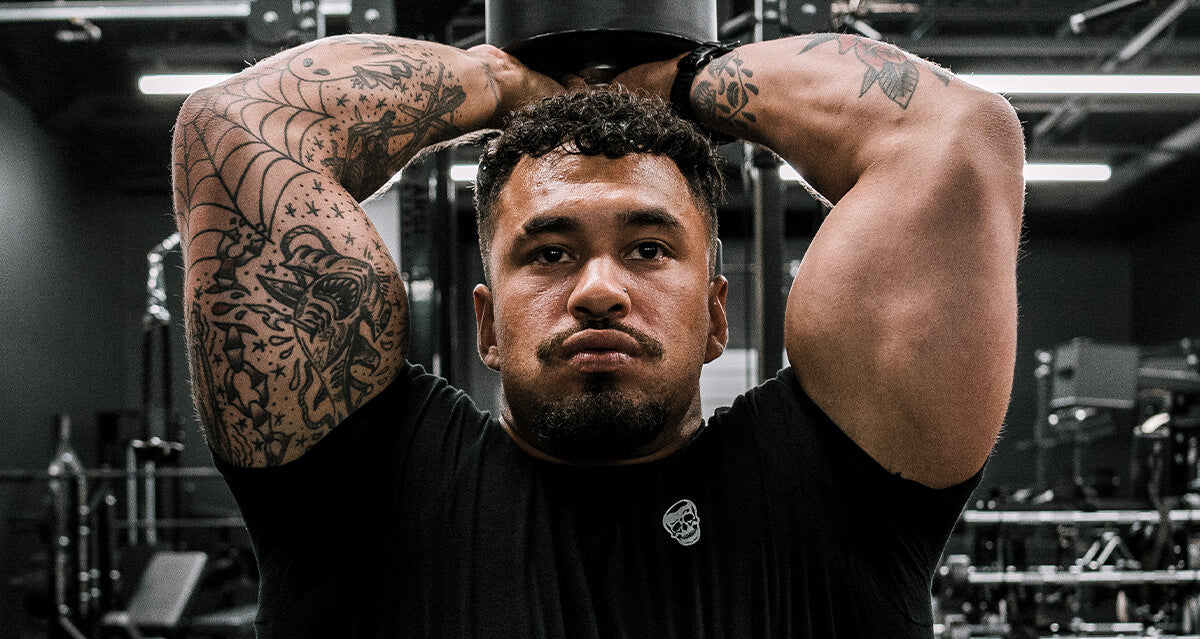If you want to train your chest but don’t have access to equipment, you need the right exercises and strategies for adjusting volume and intensity to maximize your efforts.
In this article, I’ll walk you through the five best equipment-free chest exercises and explain everything you need to know about building a chest workout that you can do anywhere in the world.
Key Takeaways
Chest Muscle Overview
The chest muscles, primarily the pectoralis major and pectoralis minor, play crucial roles in shoulder joint movement and overall upper body strength.
The pectoralis major is a thick, fan-shaped muscle situated at the front of the chest. It is responsible for flexion, adduction, and internal rotation of the humerus.
The pectoralis minor lies underneath the pectoralis major and assists in scapular depression, protraction, and stabilization.
Boost Your Chest Workout Anywhere with Resistance Bands
Gymreapers Resistance bands are great for chest workouts when you don’t have equipment. They add extra resistance to push-ups, making them more challenging and helping you work your chest muscles more effectively. Plus, they’re easy to carry and use for different exercises, so they’re perfect for workouts at home or while traveling.

Equipment-Free Chest Exercises
1. Push-Ups
The push-up is a classic bodyweight exercise that you can do anywhere. It primarily targets your chest and other upper muscles to a lesser degree, which is why it is used as a standardized test of upper body strength worldwide.
How To:
- Start in a plank position with your hands shoulder-width apart and in line with your lower chest.
- Lower your body until your chest nearly touches the floor or as low as your range of motion allows.
- Push back up to the starting position.
Pro Tip:
Prioritize inhaling on the way down and exhaling on the way up. If you feel pressure in your lower back, focus on pulling your belly button toward your spine. You can also prop your feet against the bottom of a wall, helping you soften your hip and knee joints to avoid overarching your lower back.
Enhance Your Push-Ups with Resistance Bands:
To increase the challenge of your push-ups, try incorporating Gymreapers resistance bands. Simply wrap a band around your back and anchor it to your hands to add extra resistance. This added tension helps to engage your chest muscles more effectively and provides a more intense workout.
Why Choose Gymreapers Resistance Bands?:
- Adjustable Resistance: Ranging from light to extra heavy, find the right level for your workout.
- Versatile Use: Perfect for enhancing push-ups and many other exercises.
- Portable: Ideal for workouts at home or on the go.
Elevate your push-up routine with Gymreapers resistance bands and experience the difference in your chest training!
2. Decline Push Ups
Decline push-ups are a push-up variation with your feet elevated. The decline position places more emphasis on the upper fibers of the chest muscles, making it similar to an incline bench press.
How To:
- Place your feet on an elevated surface, like a chair or bench, so your torso is parallel to the floor.
- Put your hands slightly wider than shoulder-width with your hands in line with your mid-chest.
- Lower your chest towards the floor while keeping your body in a plank-like position.
- Inhale as you descend and exhale as you push back up.
Pro Tip:
Be selective with the surface you choose to elevate your feet because if you’re in too much of a decline, you will shift the tension away from your chest muscles and onto your shoulders and triceps. I recommend using a surface lower than hip height (i.e., a bench, picnic table, or coffee table).
3. Deficit Push-Ups
The deficit push-up is a push-up variation where you elevate your hands several inches off the floor. You can use books or yoga blocks.
This variation's advantage is that it allows you to increase the range of motion and achieve a more significant stretch in your chest muscles, increasing the stimulus for muscle growth.
How To:
- Place your hands on an elevated surface, such as yoga blocks.
- Position your hands slightly wider than shoulder width and in line with your mid-chest.
- Lower your chest as far as your mobility allows or until it is level with your hands.
- Inhale as you descend, then exhale as you push yourself back to the start position.
Pro Tip:
Add a momentary isometric hold (pause) at the bottom position of the repetition to increase time under tension on the chest fibers in the most stretched position. Increased time under tension is a potent stimulus for muscle growth.
4. Diamond Push Up
The diamond push-up is an excellent variation of the standard push-up that emphasizes the mid-chest muscle fibers and triceps by changing hand positioning.
It is usually performed with the first finger and thumb from each hand in contact with the same digits on the other hand.
How To:
- Start in a plank position with your hands close together, forming a diamond shape with your thumbs and index fingers.
- Lower your body until your chest nearly touches your hands.
- Push back up to the starting position.
Pro Tip:
If you feel this exercise in your triceps more than your chest, focus on flaring your elbows outward (away from your body) to place more tension on your pecs. An ideal elbow position is 45-70 degrees from your body in the bottom position; avoid a 90-degree angle, as this puts too much stress on the shoulder joint.
5. Side-to-Side Push Up
The side-to-side push-up is an advanced variation of a push-up, which makes for a good progression from the above variations.
How To:
- Assume a push-up position and place your hands wide enough that your forearm angle is either vertical or slightly angled away from you in the bottom position of the push-up.
- Once your hand position is adjusted, descend into the bottom position of the push-up and hold.
- While holding onto a fixed distance from the ground, straighten one arm to shift your torso towards the other arm, then straighten the other arm to shift your torso to the other arm as this arm bends.
- Repeat this process for subsequent repetitions.
Pro Tip:
To reduce discomfort in your shoulders and elbows, keep most of the pressure on the bottom of the palm throughout the repetitions.
How To Structure An Equipment-Free Chest Workout
Here is a quick start guide for building a chest routine that you can do anywhere:
Frequency
Frequency will depend massively on training availability, training experience, and how long you can train. Generally, most people should train their chest 1-3 times weekly to see muscle growth.
For beginner to intermediate experienced individuals, 1-2 times weekly is a good place to start. More advanced lifters would benefit from bodyweight chest training 2-3 times weekly.
Sets
To effectively target the chest, beginners should aim for 6 sets per week. Depending on the exercise difficulty, more experienced lifters would benefit from 12 to 20 sets weekly.
Reps
When training solely with your body weight, you must focus on pushing yourself closer to failure (technical failure, not complete failure) to encourage muscle adaptation. Therefore, the goal should always be to do as many reps as possible with good form.
That said, if you can easily do more than 30 reps per set, it’s time to switch things up to increase the difficulty.

Progression
Progression is relatively simple as you have the constraint of having no equipment. You cannot increase the overload through weight, so you can only progress by increasing the time under tension, adding more volume, or choosing a more challenging variation.
To increase time under tension, you can slow the tempo of the lowering phase of each push-up variation and/or add a pause at the bottom of each rep.
To increase volume, you can add additional reps or additional sets.
Here is how it may look:
Week 1
Set 1 - Baseline (2-3 reps in reserve)
Set 2 - Baseline (2-3 reps in reserve)
Set 3 - Baseline (2-3 reps in reserve)
Week 2
Set 1 - Baseline +1 rep
Set 2 - Baseline +1 rep
Set 3 - Baseline +1 rep
Week 3
Set 1 - Baseline +2 reps
Set 2 - Baseline +2 reps
Set 3 - Baseline +2 reps
Week 4
Set 1 - Baseline +3 reps
Set 2 - Baseline +3 reps
Set 3 - Baseline +3 reps
Week 5
Set 1 - Baseline + 3 reps
Set 2 - Baseline + 3 reps
Set 3 - Baseline + 3 reps
Set 4 - Baseline + 3 reps
If you get to the point where you can do 3 or more sets of 30 reps, choose a more challenging variation or increase time under tension.
Alternatively, you can invest in quality bands like Gymreapers resistance bands for added resistance during push-ups. You can take these bands with you anywhere to increase the intensity of your workouts.
Sample Chest Workout You Can Do Anywhere
Beginner 1-Day Chest Workout Example:
Day 1
- Standard Push-Ups: 3 sets of 12 reps
- Decline Push-Ups: 3 sets of 8 reps
Advanced 2-Day Chest Workout Example:
Day 1
- Decline Push-Ups: 3 sets of 15 reps
- Diamond Push-Up: 3 sets of 10 reps
Day 2
- Deficit Push-Up: 3 sets of 12 reps
- Side to Side Push-Up: 3 sets of 8 reps
Frequently Asked Questions
Can You Build Muscle Without Equipment?
You can build muscle without equipment by utilizing bodyweight exercises that effectively target the muscle groups. Your muscles do not recognize the equipment used; instead, they are affected by the tension imposed on them. As long as your sets are close enough to failure, your muscle fibers will be encouraged to grow.
Will Push-Ups Build Your Chest?
Push-ups are highly effective for building chest muscles as they engage the pectoralis major and minor, along with the shoulders and triceps as the prime movers.
How Many Push-Ups Should I Do In A Workout?
The number of push-ups you should do will vary based on your fitness level. What matters most for stimulating muscle growth is completing 6-20 weekly sets and pushing yourself close to failure during each of these sets.
Alternatively, you can invest in quality bands like Gymreapers resistance bands for added resistance during push-ups. You can take these bands with you anywhere to increase the intensity of your workouts.
Sample Chest Workout You Can Do Anywhere
Beginner 1-Day Chest Workout Example:
Day 1
- Standard Push-Ups: 3 sets of 12 reps
- Decline Push-Ups: 3 sets of 8 reps
Advanced 2-Day Chest Workout Example:
Day 1
- Decline Push-Ups: 3 sets of 15 reps
- Diamond Push-Up: 3 sets of 10 reps
Day 2
- Deficit Push-Up: 3 sets of 12 reps
- Side to Side Push-Up: 3 sets of 8 reps















Leave a comment
All comments are moderated before being published.
This site is protected by hCaptcha and the hCaptcha Privacy Policy and Terms of Service apply.